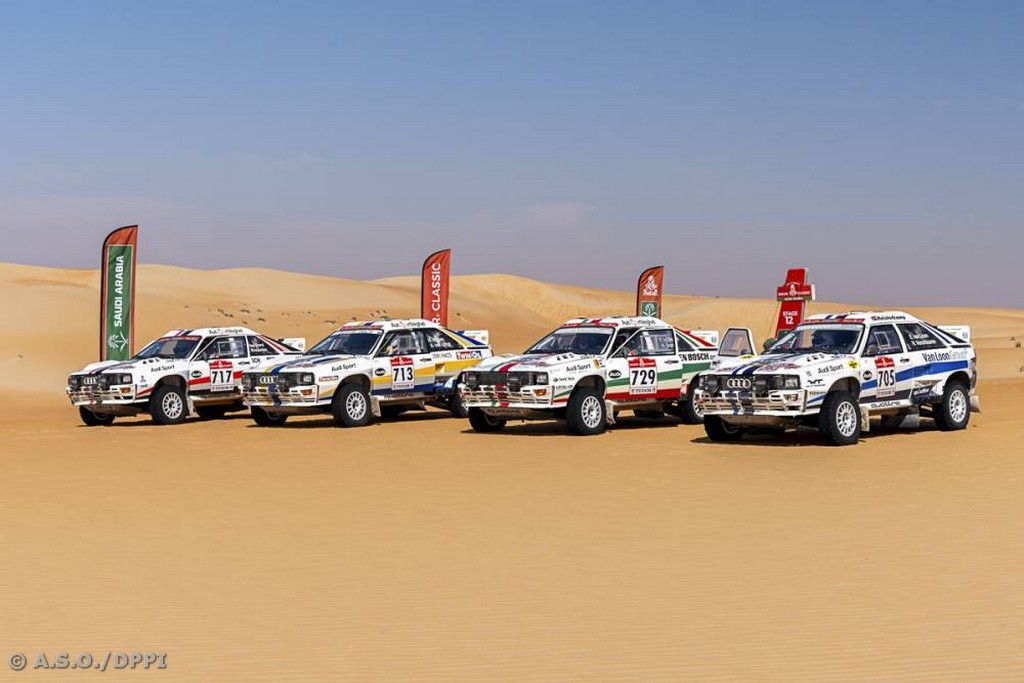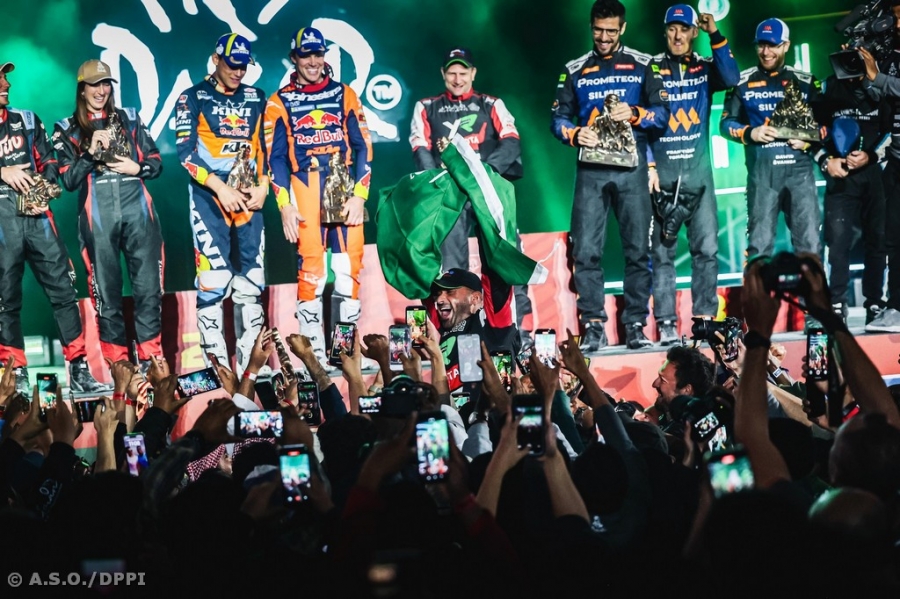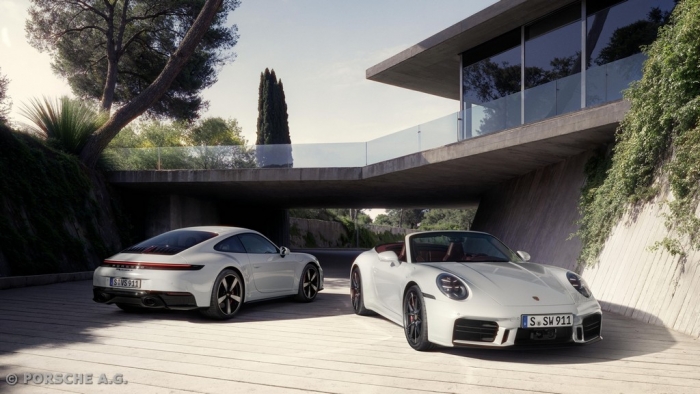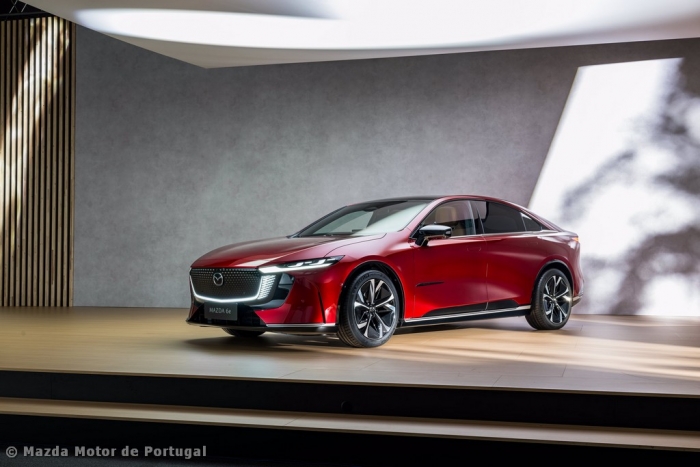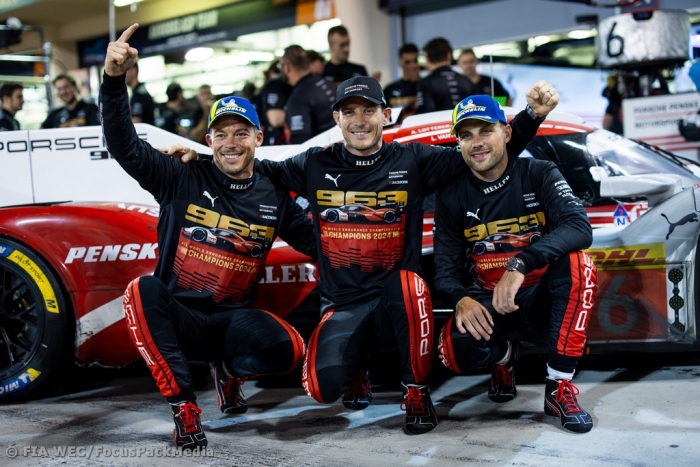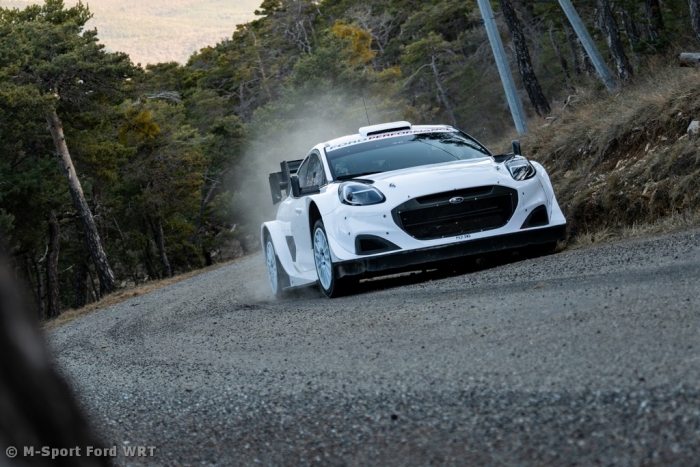77 bikes (including 67 Rally 2), 40 Ultimate cars, 1 Stock car, 21 Challengers, 23 SSVs and 13 trucks reached the final finishing line after covering the entire 7,453 km (FIM) or 7,828 km (FIA) of the route. 52 vehicles that used their jokers also finished, while 108 were forced into premature exits from the rally (i.e., 32.24%). The bike race witnessed a return to the top step of the podium for KTM, which enjoyed its 20th triumph on the race thanks to the unshakable Daniel Sanders who became the second Australian winner on the Dakar after having dominated the race from start to finish, as Marc Coma did in 2009. The Dakar roll of honour welcomed a new name and a new nationality in the car category thanks to Yazeed Al Rajhi: the Saudi driver persevered until his 11th participation to enjoy his date with destiny, with the rare privilege of winning the rally on home soil, as was the case when Pierre Lartigue triumphed in 1994 on the Paris-Dakar-Paris! With Nicolas Cavigliasso (who triumphed in the quad category in 2019) winning the title in the Challenger class and Brock Heger in the SSV race on his 25th birthday, two new drivers also triumphed. Only Martin Macik, who dominated proceedings in the truck category, victoriously defended the title he conquered last year.
The Dakar Classic race for consistency came to a close with 80 vehicles (as opposed to 95 starters). Spanish title holder Carlos Santaolalla triumphed to become the first double winner since the creation of the category in 2021. The five vehicles enrolled in the Mission 1000 challenge completed their journey through Saudi Arabia, over a distance of 1,300 kilometres for this second edition. Progress was made since last year in terms of range and performance for the KH7 truck driven by Jordi Juvanteny, who already won in 2024, as for the hydrogen-powered HySe SSV. The three Segway electric bikes, which were newcomers to the challenge, also validated their technology on the terrains of the Dakar and can look forward with a whetted appetite to 2026.
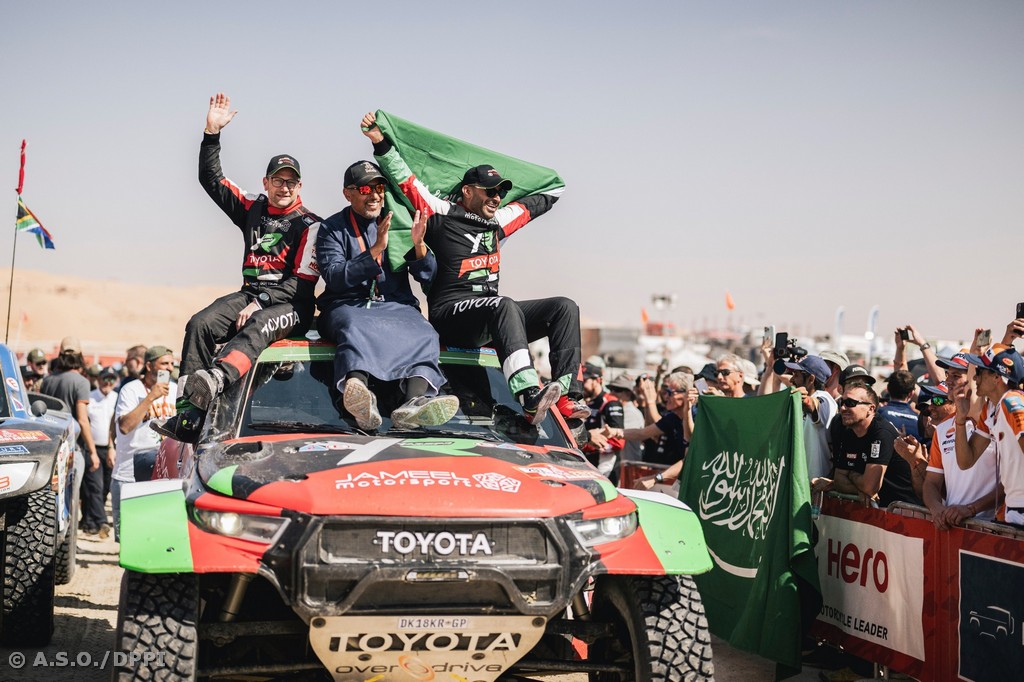
Ultimate: Patience proves the wiser for Al Rajhi
• With a solid return to the Dakar following his absence in 2024, Henk Lategan moved into the lead at the halfway point, added a stage success to his roll of honour and held steady until the ninth special when he suffered from having to open the way. Yazeed Al Rahji, who was trailing in the South African’s wake until that day, took two tries to get ahead of him and particularly make the difference on the loop around Shubaytah. The Saudi driver took revenge on the Empty Quarter where he was eliminated in 2024: on the eve of the finish, he had a lead of six minutes over his closest rival, which was sufficient to complete the rally with a lead of 3’57’’ and win his first title on his eleventh participation. Among previous Dakar winners, only Jean-Louis Schlesser was just as relentless before triumphing in 1999.
• Behind the duellists who featured at the forefront throughout the rally, the battle for the third step on the podium was contested by Mattias Ekstrom and Nasser Al Attiyah. The Swedish driver moved into third on stage three and never left the position. His consistency and stage victory in Shubaytah (on stage 11) helped to soften the blow of Carlos Sainz’s premature exit for the Ford clan, which left its mark on its first appearance on the Dakar. Ekstrom especially kept his cool in the face of attacks from Nasser Al Attiyah, whose rare mistakes made alongside Edouard Boulanger were sufficient to keep him in fourth place, from the marathon stage onwards. For its debut on the race, Dacia had to deal with the disqualification of Sébastien Loeb for safety reasons but can still be happy with reaching the finish, a stage victory and an honourable final position for its Qatari champion.
• X-raid also inaugurated a car, with the new petrol-powered Mini, though it leaves Saudi Arabia with meagre spoils: a stage win for Guillaume de Mévius, who had already lost all hope of battling with the best for the title, before a spectacular crash sent Guerlain Chicherit back to his home in the French Alps. The leading Mini to finish was brought home by Joao Ferreira, who achieved 8th position at the age of 25 years, but in a diesel-powered version.
• In the top 10 positions desired by many competitors at the start, a second Raptor driven by Mitch Guthrie broke into the ranks of the elite (with 5th place), while the switch to T1+ by Mathieu Serradori allowed him to improve his personal best by one position (6th). At the end of the day, sensations from young talented drivers were less visible than in the first week but with 7th place by 25-year-old Argentinean Juan Cruz Yacopini and 9th place by 22-year-old Seth Quintero, the Dakar youth have confirmed that the new generation of drivers is continuing to make steady progress. • Following the premature exits of Laia Sanz and then Christian Lavieille, Pierre Lachaume has proved to be the leading two-wheel-drive competitor, almost two hours ahead of his Spanish MD Rallye Sport team-mate Ferran Jubany.
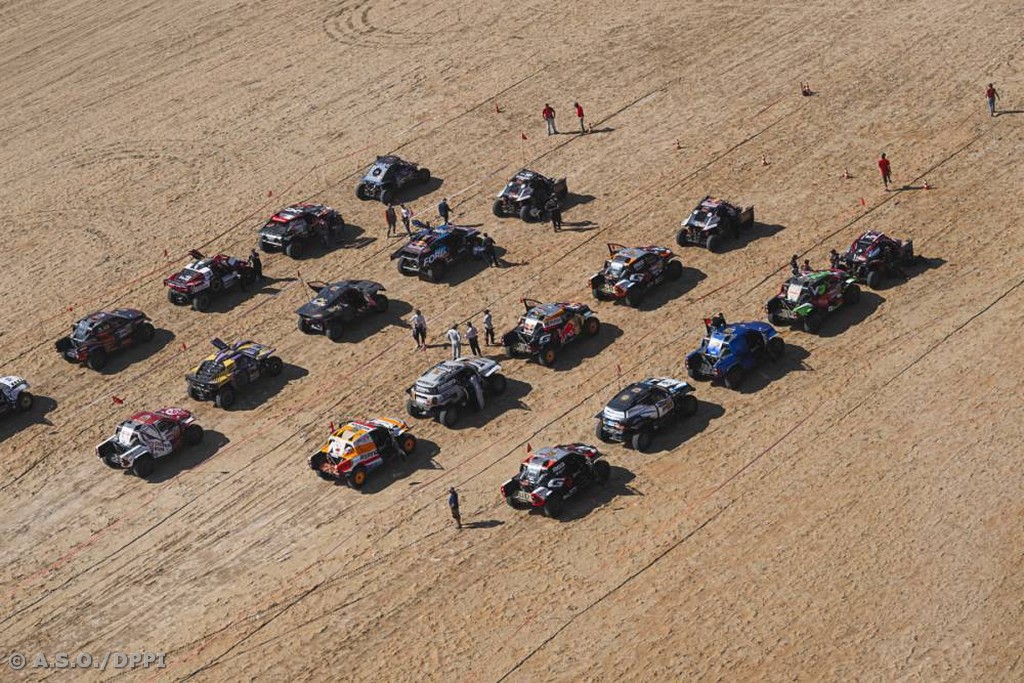
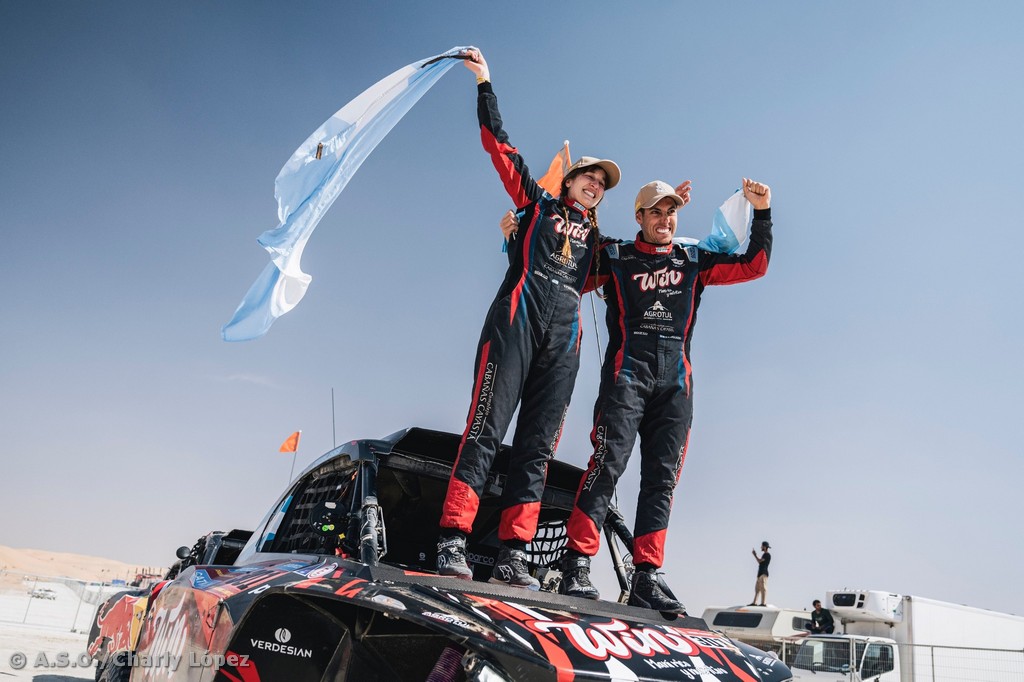
Challenger: A seamless performance from Cavigliasso
• Like Sanders and Canet in the bike race Rally GP and Rally 2 classes, Nicolas Cavigliasso and his wife Valentina Pertegarini remained in the lead of the general rankings from Bisha onwards. The Argentinean couple, with the experience of the 2024 W2RC season that they completed in 2nd place, avoided all the pitfalls on the route of the Dakar and finished with a lead of more than one hour over their nearest pursuers.
• The two recruits to the Red Bull Off-Road Junior Team who were making their debuts in the big league managed to leave their mark on the Dakar. Due to mechanical problems before the rally’s halfway point, Corbin Leaverton was unable to shine in the general rankings but the American achieved five podium finishes including two victories. His team-mate Gonçalo Guerreiro, who already boasted experience on the European circuit, displayed consistency by climbing onto four stage podiums without winning. The Portuguese driver finished in second position, 1:11’38’’ behind the winner.
• On the final podium, 1:30’13’’ behind his winning team-mate with BBR, Pau Navarro made a name for himself on the rally in in the second week. The Spaniard featured on all the stage podiums and achieved two victories.
• Yasir Seaidan, who won three stages like Nicolas Cavigliasso, was let down by steering problems at the beginning of the race and the Saudi driver was unable to make up for this mishap. His countrywoman Dania Akeel picked up her first victory on the Dakar on stage 10. In addition to the one obtained by Yazeed Al Rajhi, the Saudis have set a new record with 5 stage successes on the sixth edition of the rally on their home soil.
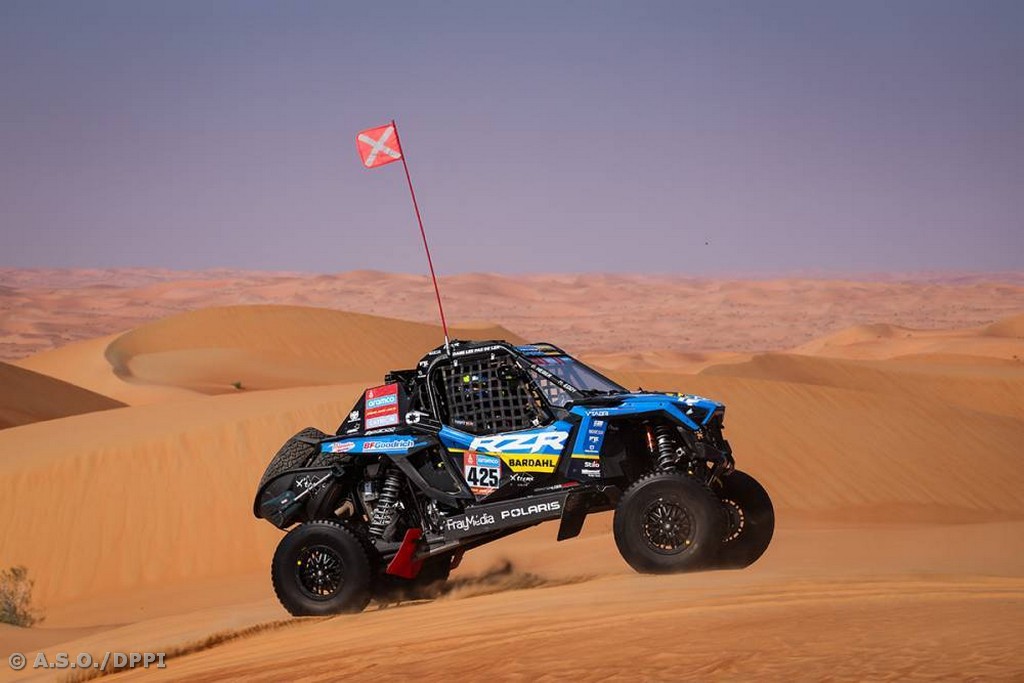
SSV: Heger keeps the trophy for Polaris
• The Polaris drivers dominated the first three specials in the SSV race, with their designated rivals behind the wheels of the Can-Am Maverick R suffering due to their greenness on the race or because of mechanical problems. The RZRs driven by title holder Xavier de Soultrait and rookie Brock Heger led the general rankings from start to finish.
• The advantage was with the American from stage 4 onwards when the French title holder damaged his front-end assembly. Two more repetitions of this setback finally deprived Xavier de Soultrait of an overall podium place on completion of the penultimate stage. Brock Heger triumphed on his first participation allowing Polaris to keep the Tuareg trophy.
• ‘Chaleco’ Lopez, who returned to the category after three editions of the Dakar in the Challenger class, lost all chance of overall victory on stage 2. The Chilean subsequently made a storming comeback, picking up five stage successes, a record for this edition of the rally, shared with biker Daniel Sanders and truck driver Martin Macik, allowing the official Can-Am driver to finish in 2nd place, albeit more than 2 hours behind the winner..
• Sara Price, who was forced to exit the special on the 48 HR Chrono stage due to a mechanical problem, won three stages. The American is the most successful woman driver in terms of stage wins on this edition, ahead of Dania Akeel.
• Alexandre Pinto finished in 3rd position in the general rankings, more than 3 hours behind Heger. The young 25-year-old Portuguese driver is the leading privateer in the category.

Trucks: Macik makes it number two
• The title holder put in a perfect performance. Following a three-way fight with Ales Loprais and truck category newcomer Vaidotas Zala, the Czech driver soared away as from stage 3, taking complete control of the general rankings following his rivals’ mishaps on the 48 HR Chrono stage. The boss of MM Technology won five stages, as many as Loprais, which is the joint record on this edition.
• The fight for second place was then contested by Ales Loprais and Mitchel ven den Brink. Following 4th place in 2022 and 3rd place in 2024, the young Dutchman, who celebrated his 23rd birthday on stage 9, finished in second position, 5’30’’ ahead of the Czech driver.
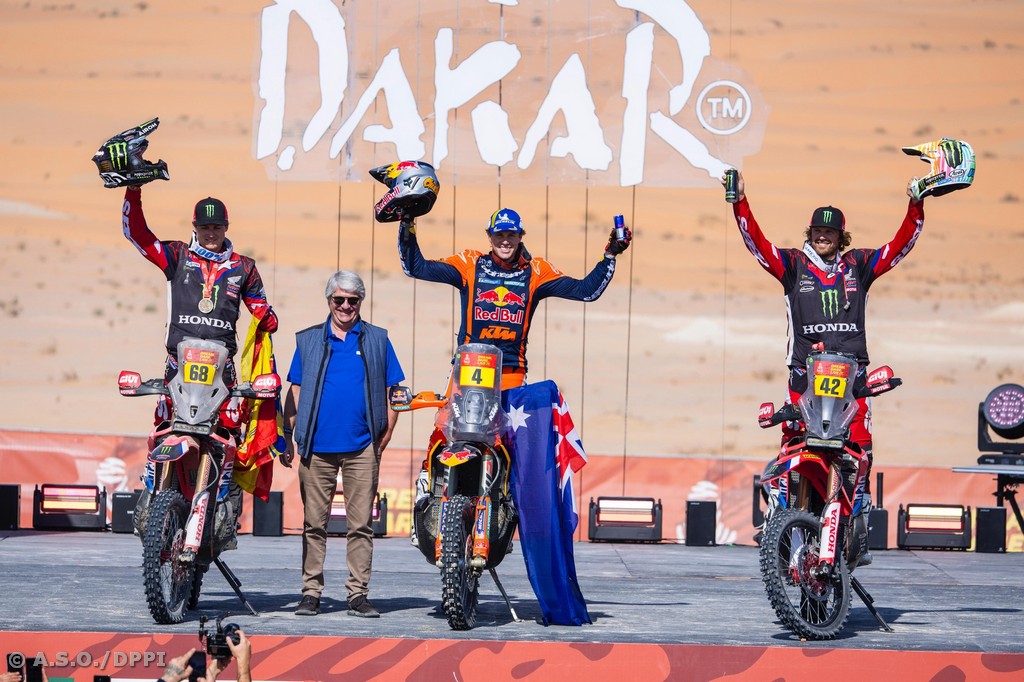
Bikes: A first for Sanders, a twentieth for KTM
• RNothing could stop Daniel Sanders this year. ‘Chucky’ was the main man in the first week of the rally, winning 4 out of the 6 specials, and managed his lead perfectly in the Empty Quarter. The master strategist on the 2025 edition obtained his first triumph and the third for Australia following Toby Price’s two titles (in 2016 and 2018). He also became the first rider to win when leading the general rankings from start to finish since Marc Coma in 2009, bringing career consecration for the 30-year-old rider on his fifth attempt at the rally.
• As in 2024, Honda placed two machines on the podium. Tosha Schareina (in 2nd position) obtained his first medal on the Dakar, while Adrien Van Beveren (3rd) repeated his performance from last year. Luciano Benavides (4th) achieved the best result so far in his career, while title holder Ricky Brabec completed the top 5.
• Edgar Canet, the youngest official rider in history at the age of 19 years, also became the youngest rider to win the Rally 2 class, as well as finishing as the best rookie. The emerging Spanish star triumphed in front of Austrian hope Tobias Ebster. Romain Dumontier in third place accomplished a fourth consecutive podium finish in the class and was also the leading non-KTM rider behind the handlebars of his Honda.
• The duel between Emanuel Gyenes and Benjamin Melot for victory in the Original by Motul class kept the bivouac guessing until the final kilometre. The Romanian won by a whisker (3’05’’) in front of the Frenchman, repeating the top two from the 2020 edition.
• The young riders who recently joined the Dakar caravan put in respectable performances and gained experience. Neels Theric (15th) gave Kove the best result in its history as well as for a Chinese bike on the rally. The same was true for Jérémy Miroir (27th) with Italian brand Fantic. Hoto made its debut this year and put three machines in the top 40, with the leading bike of the three ridden by Xavier Flick (28th).
• With its 20th triumph, KTM reinforced its position of leading constructor in terms of overall victories on the Dakar. In addition to winning all the bike classes, the Austrian firm picked up 8 out of the 13 specials (5 for Sanders, 2 for Benavides and 2 for Michael Docherty). Honda finished with 3 stage successes (Van Beveren, Brabec and Schareina), while Sherco reacquainted itself with victory once thanks to Lorenzo Santolino.
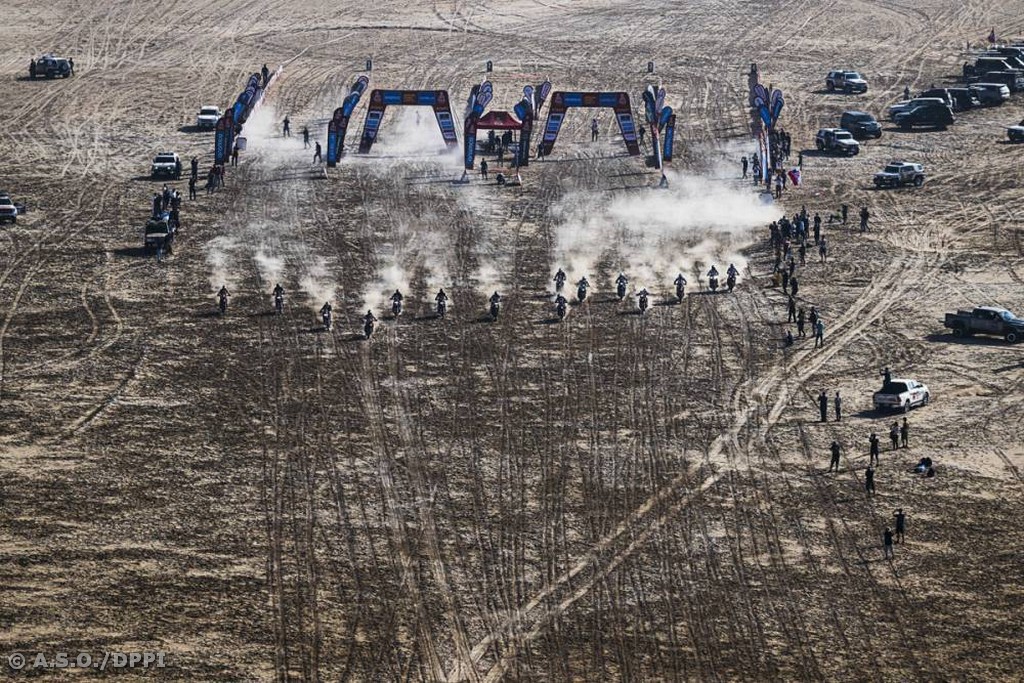

Dakar Classic: Santaolalla and Traglio do it again
• Carlos Santaolalla et Lorenzo Traglio remained unshakeable on the last navigation test on stage 12 of the 5th edition of the Dakar Classic. The 31-point gap in favour of the Spaniard therefore remained unchanged and the Toyota HDJ 80 driver has become the first competitor to win twice on the Dakar Classic.
• The Italian in his Nissan Terrano Tecnosport is again runner-up. The 2025 edition of the Dakar Classic was marked as the emergence of specialists in the exercise, among which 2023 winner Juan Morera featured. The driver of the Porsche 959 Replica, who for a long time looked set to feature on the final podium, exited the race early due to a burned-out clutch.
• The Land Rover driven by the Gublin-Sousa crew, which also featured on the provisional podium several days ago, was forced out of stage 10 with a broken gearbox. The other Land Rover, namely the Series III driven by Karolis Raisys, climbed onto the podium instead, 300 points behind the winner.
• Following the Sunhill buggy in 2021 with a French driver behind the wheel, this is the third victory for a Toyota HDJ 80 and a Spanish driver.
